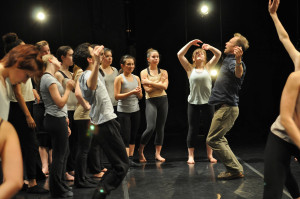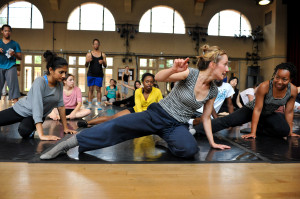Over my 20+ years of teaching, I’ve seen different trends and styles come and go. I’ve watched modern dancers go in and out of dedicated periods of ballet training. I’ve seen yoga grow from a fad into an essential practice. I’ve seen the positive impact of somatic practices like Feldenkrais, Alexander and Gyrotonic on dancers’ health. I’ve watched ballerinas toss off their pointe shoes in favor of ankle socks. Dance is a fast-moving field of change, exploration and innovation.
As a teacher, I’ve often wondered how new styles and trends impact the way students train. What do today’s dance students look for in a technique class? The old model of training with one person for a decade or more is nearly extinct. Training with multiple teachers and in different dance forms and related somatic practices (like yoga, Pilates, etc.) is more the norm nowadays. So under the moniker of “dance technique,” what do we take the time to teach? And what do today’s dancers need to know?

To explore some of these questions, I had the privilege to speak with a few Bay Area teaching artists whom I’ve admired for their ability to train skillful and intriguing dancers and for their impact on me both in the classroom and personally. Diane Frank, Nina Haft, Katie Faulkner, Christian Burns and Kara Davis each talked with me about why they teach what they teach, how they respond to the changing fashions of dance, and how they strive to keep evolving as teaching artists. Here is some of what they had to say.
Christian Burns: To me, the number one most important thing about what I value in teaching is experience. I feel strongly connected to the master/apprentice model. I don’t necessarily want to have an academic experience. If you want to learn something well, you have to find someone who has done that one thing. Institutional pedagogy doesn’t matter. I teach what I know and what I understand.
I went through a time when I was trying to hybridize my improvisational practice with classical classes, which is clearly a trend these days. I tried to create hybrid classes and I had the realization that the dancer I became wasn’t because people were teaching me to be a hybrid dancer. I had improvisation and classical training and it was in the distance between those two things that I found my education.
Katie Faulkner: I try to build class material around the puzzle of who are these people, what is the atmosphere, what is this class trying to do, what kind of work and experiential play can I access choreographically and make fun for me.
This world moves quickly. Dance is such a youth valued form. What people are able to do is always so important. Things are never fully stable. You can never really rest on solid ground—that’s why I named my company what I did! [little seismic dance company]. It requires a constant re-evaluation. It’s hard. I’ve had many moments when I’ve not been sure if I’m doing anything that matters at all. I think that’s why the relational community aspect [of class] has been so important [to me]. There’s always going to be some younger, cool person who will come along and dazzle everybody. And yet, if you have a real commitment, while it may not stay the same shape always, there is something important about staying available to people.

Kara Davis: When I was at the height of my dancing I was obsessed with Forsythe. I wanted to know the language. I wanted to know concrete means by which to generate movement. It’s not so trendy now, but it’s still relevant. It’s in my body. It’s in my movement. I’m really glad I studied Gaga when I did, before it started to spread into the world. It felt much more raw and about reaching a different state from which to pull out a different power. I keep my experience of it and I’m not much into the trend of it.
Diane Frank: Some of the things that are important to build a highly versatile dancer are things that people don’t necessarily want to do because they’re attracted to a certain niche of movement. If you’re doing a lot of things that are spectacular and that pop back to the center, as in hip hop, for example, you’re probably not travelling across the space or experiencing legato movement. To be versatile you may have to experience something that isn’t coming from your favorite movement style.
I think the long view of dance training is gone. People taste. They show up to the first class, and none of them have taken the class and there is a certain entertainment people want in that first class. Someone who wants to attend to something deeply will take this class. It’s not entertainment, it’s training—it’s the opportunity to train.
Mary Carbonara: What do you think dance students need in their training these days? Do you have a particular focus in your current classes? What’s of special interest to you right now?
DF: I’d like to see people not only taking technique class, but getting more exploratory opportunities to discover what their own dancing is. When people have to explore something they discover themselves and loop it back to something they’ve learned in technique. That’s when people really leap forward. I want to see people inhabit the movement. I want to see them carried away. This [dance] is one of the last places where things are transferred body to body. It has to happen in the studio, it doesn’t happen anywhere else.
Nina Haft: There’s really one question that I’ve been focusing on because I’m really curious about it and because it’s germane to taking technique to performance: how to integrate sensory awareness of your own body and take it into awareness of space around you. I see really compelling performers that may not have great technical prowess but are doing great things on stage and vice versus, but rarely do I see both. I think it’s something that’s lacking in performance.
KD: I try to get my students to move more from their pelvis and the other powerful parts of the body that aren’t the limbs because then they can work less and be efficient. I have them work on how to occupy a receptive, listening state, rather than a charged, adrenaline state. Class can become a laboratory.
KF: I think what I try to do is approach the way I plan a class guided by the things I love most about dance: being in community with people, relating to movement through my own sense of artistry, increasing my own awareness of my body and how I can get better and change and be lost. I’m guided by those interests more so than in passing on a particular kind of training or lineage.
I think I also come at this as someone who is interested in choreographing. I love making up movement material. I love thinking about who the students are and meeting them where they are and how open they are to what I’m doing. Sometimes I feel like an ambassador of modern dance, providing a positive, exciting relation to it, challenging their relationship to it.
I do think a lot about what kind of dancers I’m trying to train. I try to look around to see what’s happening in the dance world and what kind of world these dancers are moving into. Academically, I teach in a liberal arts setting where students don’t have to audition to be enrolled. I approach it from the perspective of wanting to teach them to be well-rounded people, how to think and why this form matters. I want to help them find in themselves their own value system and what feels powerful to them about being in the body.
MC: Teaching requires a unique commitment to your own values, combined with an enormous amount of energy and focus, so different from choreographing, performing or rehearsing. Meanwhile, it can sometimes be effortful evoking from your students authentic change and improvement. Is there anything particular in your teaching with which you struggle or are trying to do differently?
CB: I can get very frustrated sometimes, but increasingly I feel like my teaching is the real center of my creative life. When I’m teaching I’m in direct contact with my history and the languages and space. It’s a wonderful dialogue. When I’m doing ballet, it’s all about giving over to becoming the vessel to the form. We all know that we’re also thinking and feeling and going through experiences. Even in this practice, we’re also learning how to be content, how to be in the form, how to be present, mindful of how we’re doing it. Improvisation is the reciprocation, it’s about becoming, it’s emphasizing where you are, not the body. It brings up wonderful philosophical questions. Where are you and all those levels that can be explored. I don’t get bored, because I find it so interesting. There are definitely areas in which I’m still growing.
DF: I love working with students with a tremendous appetite and it’s fun to work with people who are ready to take on a lot of complexity. It’s harder to work with students who aren’t ready or who are even reticent. I have stopped feeling like I have to provide appetite. I have learned how to distinguish those who are reticent from those who really don’t want to be there. I’ve learned how to recognize fear. How do you get past that? Usually things need to be simpler so students can go deeper. I used to feel like I had to lure people in.
KF: I’m doing my Laban Movement Analysis certification this summer. I think it’s going to give me a lot more tools for assessment. I tend to be an imagery-based teacher and I’m looking forward to having more tools. I know that some students need hands on stuff or need you to break down the anatomy in someway. That’s one of the areas that I want to strengthen—my ability to reach different learners.
NH: I wish I could have a wider range. Sometimes I try to imitate what I think a certain choreographer would do if they were making movement. It’s one of the ways I try to trick myself into composing movement differently. In that way being a teacher is a great way to study and grow. I’m happiest teaching when it’s stretching my choreographic imagination.
KD: As soon as I get bored with dancing—which I don’t think will ever happen—it will be because I’ve stopped asking questions. It’s never been about arriving at an answer.
Christian Burns, burnswork.org,
Kara Davis, project-agora.com,
Katie Faulkner, littleseismicdance.org,
Diane Frank, stanford.edu/dept/dance/index.html,
Nina Haft, ninahaftandcompany.wordpress.com
Read part one of this three part series online at dancersgroup.org.
This article appeared in the May 2014 issue of In Dance.

